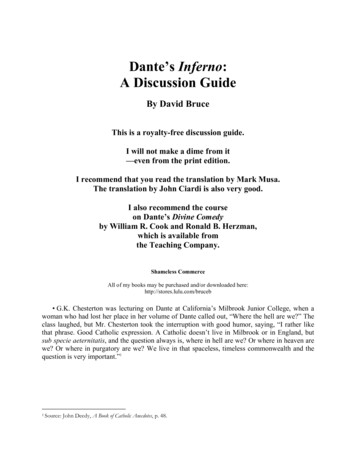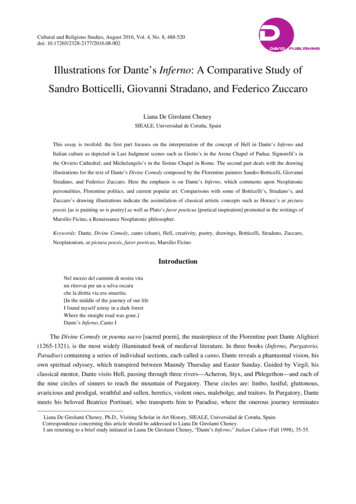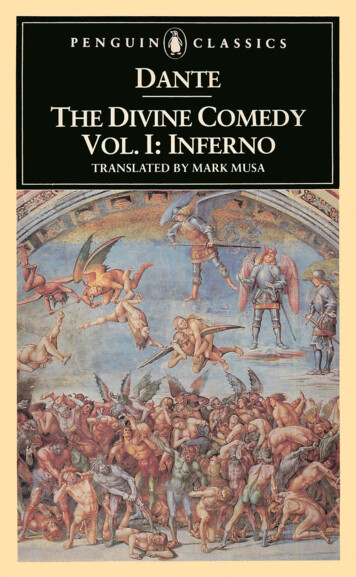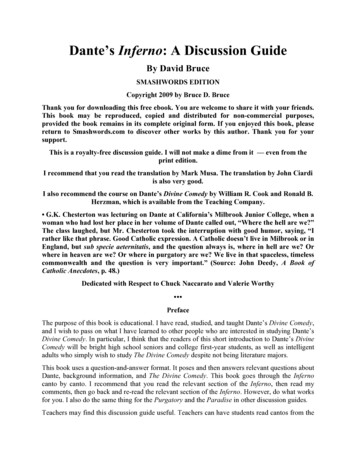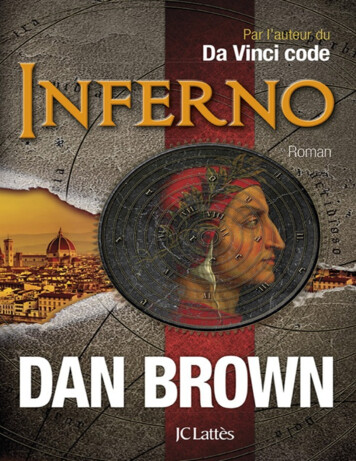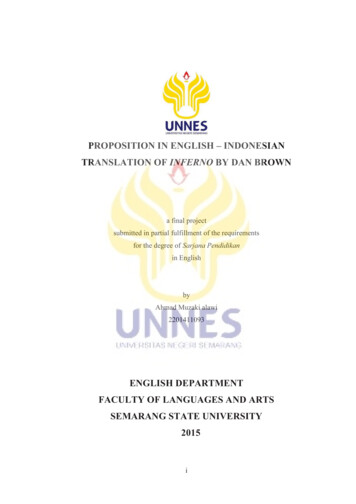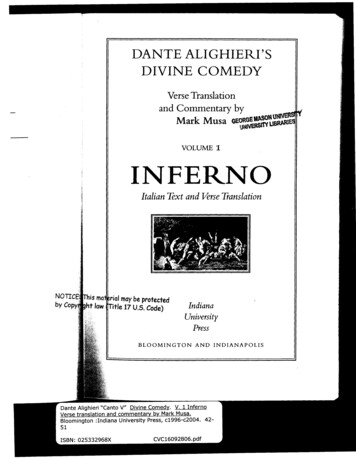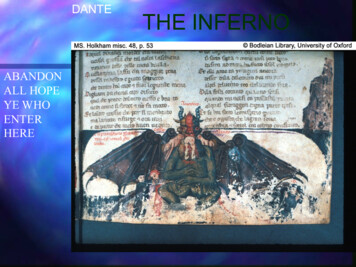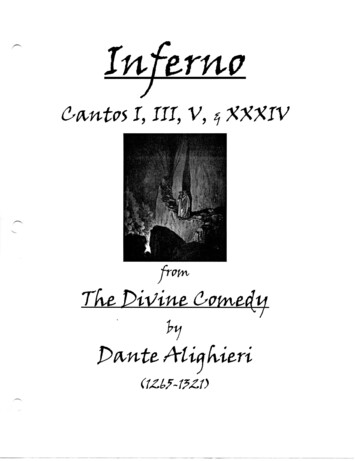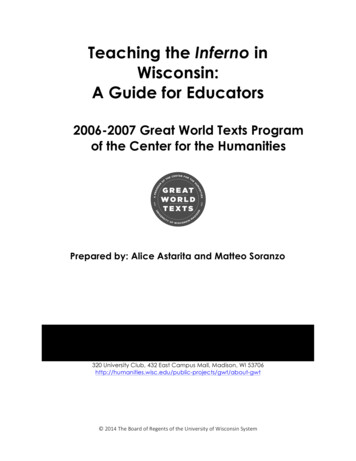
Transcription
Teaching the Inferno inWisconsin:A Guide for Educators2006-2007 Great World Texts Programof the Center for the HumanitiesPrepared by: Alice Astarita and Matteo Soranzo320 University Club, 432 East Campus Mall, Madison, WI t/about-gwt 2014 The Board of Regents of the University of Wisconsin System
CloseReading?.351Teaching the Inferno in WisconsinGreat World Texts: A Program of the Center for the Humanities, University of Wisconsin- ‐Madison 2014 The Board of Regents of the University of Wisconsin System
HowtoUsethisGuideA note on context: Reading Across Tim e and SpaceDante’s Inferno is a work of fiction. While its sociocultural and geopolitical contexts areintegral to its impact, and to our critical reflections on the texts, it is important to rememberthat this is a work of literature and not a historical document. While literature can help usteach culture, history, psychology, current affairs, and so on, no one text can bear the burdenof representing an entire nation, culture, or people.How to Use this GuideThe material in this guide is intended to provide much of what you will need to teach thenovel and its context. We believe that the historical and cultural background is necessary tounderstanding the novel, its characters, and their decisions, but we encourage you to teachthe novel thematically, and tie it into other disciplinary issues and regular features of yourcore curriculum wherever possible.Readings, reviews and handouts: The reviews and readings in the guide are intended forteachers, but some of them may also work well as student handouts. These include readingsthat provide further background information for instructors as well as a variety of materials(especially from the internet) that might aid instructors in creating handouts, for example.You are encouraged, where possible, to use the materials in this guide as handouts for yourstudents.Lesson plans and suggestions for discussion: The lesson plans and activities provided in thisguide are designed to allow you the opportunity to tailor the way you teach the text to yourown course, time constraints, interests, and goals. The individual units could be taught overone or several days or weeks, and you can mix and match ideas from the various sections tocreate your own syllabus.Focused Reading: Although the guide assumes that one has read the entire novel, most unitsinclude specific passages for a focused reading—an area of the text from which the majorideas and themes of that unit are drawn and which can serve as an example of the majorconcepts discussed.Close Reading StrategiesMost of the lesson plans include focused readings, which are passages from the novel thatillustrate a certain theme or idea for that particular unit. During discussion and forassignments, students should be encouraged to support their interpretations with evidencefrom the text. Close reading lends itself well to group work and to small- ‐group discussions,and is an excellent way for students to learn both critical thinking and analysis skills as theymake connections, use evidence to support their views, and discuss the impact of variousliterary techniques. For close reading to work successfully, it’s important that the teacher2Teaching the Inferno in WisconsinGreat World Texts: A Program of the Center for the Humanities, University of Wisconsin- ‐Madison 2014 The Board of Regents of the University of Wisconsin System
always remind the students to point to the passage/line/occurrence that supports theirposition as they share their ideas. Close reading teaches students the difference between“opinion” or “personal reaction” and “analysis.” It also helps teach students to assess thetexts of its own merits, and avoid essentializing the cultural components of the text orstereotyping based on generalizations.Reading a portion of text out loud as a class or small group, followed by group analysis, canbe an excellent way to develop close reading skills in the classroom.The guide also includes a handout on close reading that we encourage you to use in yourclasses.For Further Inform ationIf you have any questions about this guide, or would like additional information on any of thematerials here, please contact the Great World Texts coordinator atgreattexts@humanities.wisc.edu.3Teaching the Inferno in WisconsinGreat World Texts: A Program of the Center for the Humanities, University of Wisconsin- ‐Madison 2014 The Board of Regents of the University of Wisconsin System
ation- ‐- isitssubject?Themetricalscheme- ‐- ‐terzarima"thirdrhyme"- ‐- iterarytradition- ‐- alarchetypal/typological4Teaching the Inferno in WisconsinGreat World Texts: A Program of the Center for the Humanities, University of Wisconsin- ‐Madison 2014 The Board of Regents of the University of Wisconsin System
teron- dethegreatrefusal"(vv.59- mula"Vuolsicosì."("Itissowilled.")(vv.95- ‐96)5Teaching the Inferno in WisconsinGreat World Texts: A Program of the Center for the Humanities, University of Wisconsin- ‐Madison 2014 The Board of Regents of the University of Wisconsin System
TheVirgiliansubtext(AeneidVI,309- etree(vv.112- 2- aching the Inferno in WisconsinGreat World Texts: A Program of the Center for the Humanities, University of Wisconsin- ‐Madison 2014 The Board of Regents of the University of Wisconsin System
dusaThecrucialtercet:vv.61- fElijah- ‐- ‐ascentandapotheosis- ‐- ofthecantoandFortunatus'shymnThearch- ng the Inferno in WisconsinGreat World Texts: A Program of the Center for the Humanities, University of Wisconsin- ‐Madison 2014 The Board of Regents of the University of Wisconsin System
Luciferasthe"Anti- dthepassagefromHelltoPurgatory8Teaching the Inferno in WisconsinGreat World Texts: A Program of the Center for the Humanities, University of Wisconsin- ‐Madison 2014 The Board of Regents of the University of Wisconsin System
roductoryDiscussionSuggestedprompts Whatdoyoumeanwhenyousay“MiddleAges?” Whatdoes“MiddleAges”makeyouthinkabout? dleAges? Wheredidpeoplelive?How? Whatdoes“inferno”mean? Whatishell?Whogoestohell?Why?Whobelievesthat? WhatdoyouthinkamedievalbookentitledInfernoisabout? Whatdoyouthinkthestoryisabout? toread? DoesanyoneknowwhoDantewas? ressthefollowingquestions:AbouttheAuthorandhisTime ? tydidDantebelongto? ? hatwashisoccupation? WheredidDantegowhenhewasexiled? g the Inferno in WisconsinGreat World Texts: A Program of the Center for the Humanities, University of Wisconsin- ‐Madison 2014 The Board of Regents of the University of Wisconsin System
AboutthebookentitledTheDivineComedy Whatistheoriginaltitleofthebook? tos(songs)doestheInfernocontain? Howmanycantosdotheothercanticlesinclude? Whereistheoriginalmanuscript?Wastheworkwell- ‐knowninDante’slifetime?In- heletter.Pre- CanGrandedellaScala 0Teaching the Inferno in WisconsinGreat World Texts: A Program of the Center for the Humanities, University of Wisconsin- ‐Madison 2014 The Board of Regents of the University of Wisconsin System
deservingofrewardorpunishmentbyjustice.Mini- wmanycanticlesdoesthetextinclude?a) 100b) 34c) manyd) onsin- ‐Madisond)LocationUnknownWastheworkwell- rice?a)Dante’swife11Teaching the Inferno in WisconsinGreat World Texts: A Program of the Center for the Humanities, University of Wisconsin- ‐Madison 2014 The Board of Regents of the University of Wisconsin System
wersingroupsof2ormore.HomeworkAssignmentI ltorparticularlywonderful. nt. Write2- ‐3sentencesforeach. ondshouldtheyguess!12Teaching the Inferno in WisconsinGreat World Texts: A Program of the Center for the Humanities, University of Wisconsin- ‐Madison 2014 The Board of Regents of the University of Wisconsin System
prompts Whichones? Whatarethefeaturesofanautobiography?[first- ‐personnarrative,pictures,etc.] ivatestoryofapublicevent,etc.] l/written,nativelanguage/adoptedlanguage] out?How? ksupanautobiographys/heentersintothatpact. scriptions(Unit1Homework).]Close- racticeinclass.Here,wesuggestorganizingtheclose- organizedin“pre- erstandingofthetext,and“post- eaching the Inferno in WisconsinGreat World Texts: A Program of the Center for the Humanities, University of Wisconsin- ‐Madison 2014 The Board of Regents of the University of Wisconsin System
Canto1CloseReadingQuestionsPre- 1- didhearriveinthewood?6,13- ‐14,19,21,28,588- ‐97.Whatdoeshecomparehimselfto?22- ‐2410- ‐12Post- /WhatdoesDanteLeopard:31- - ‐48beastsandofVirgil.She- ‐wolf:49- ‐54Whatisallegory?HowdoesitVirgil:61- .WhathappenstoDante34- ‐36,44- ‐48,49,54,61- ters?toa“trueman”?10.HowdoesDantetellus37- Virgilfrom?68- - ‐72when?14.WhatwasVirgil’s73,79- ‐80profession?15.WhatdoesVirgilask76- ‐78Dante?16.WhattonedoesDante79- ?17.WhatadvicedoesVirgil92- ‐99;112- ‐12014Teaching the Inferno in WisconsinGreat World Texts: A Program of the Center for the Humanities, University of Wisconsin- ‐Madison 2014 The Board of Regents of the University of Wisconsin System
und101- ‐105106- ‐108106- 109- ‐111WhymustItalybesaved?121- ‐123Whoisthiswoman?124- birthdatetothedatesofChrist.71- ‐72,125,131,25.WhydoesDantewishto130- lingedition.OtherReadings/Activities/Games1. Whatisterzarima?(SeeDurlingpages20- ‐23.)Afterresearchingterzarima,trywriting6- 2. istoshowthateveryonecanbeapoet.15Teaching the Inferno in WisconsinGreat World Texts: A Program of the Center for the Humanities, University of Wisconsin- ‐Madison 2014 The Board of Regents of the University of Wisconsin System
ching the Inferno in WisconsinGreat World Texts: A Program of the Center for the Humanities, University of Wisconsin- ‐Madison 2014 The Board of Regents of the University of Wisconsin System
yDiscussionSuggestedprompts WhydothinkDantefindshimselfinhell? Whosenthimthere? WhoaskedVirgiltobehisguideduringthejourney? WhatdoDanteandVirgilhaveincommon? DoesDantehaveamissiontoaccomplishduringhisjourney? Whatdoyouthinkhehastodo? Forwhomishewritingwhathesaw? Wheredoyouthinkhellis? Howdoyouthinkitisorganized? Whoisthedirector? Whodecidedtoinstitutehell? Whereisitsentrance? e’sintercessionClose- ‐ReadingInstructions(seeUnit1)Canto2Close- ‐ReadingQuestionsPre- ‐ReadingTeacherHints(verses)Post- ‐ReadingActivityFears1.Whattimeofdayisit?1- ‐32.WhatdoesDanterelyonto5- 10- 31- le?5.Havingconsideredsuch37- ‐4217Teaching the Inferno in WisconsinGreat World Texts: A Program of the Center for the Humanities, University of Wisconsin- ‐Madison 2014 The Board of Regents of the University of Wisconsin System
odo?WhatdoesDantecomparehimselfto?43- ‐5158- Beatrice,theVitaNuova.76- ‐8194- ‐99103- ‐109118- ‐120121- ‐126127- ech133- ‐140affectDante?18Teaching the Inferno in WisconsinGreat World Texts: A Program of the Center for the Humanities, University of Wisconsin- ‐Madison 2014 The Board of Regents of the University of Wisconsin System
sthefollowingquestions:1. tsexit?2. edinHe
nsi nSystem Teaching the Inferno in Wisconsin: A Guide for Educators 2006-2007 Great World Texts Program of the Center for the Humanities

